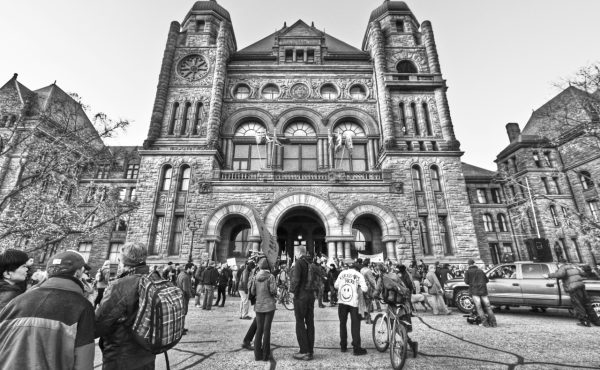 On Friday, Toronto released Change is in the Air, its proposed framework for action on climate change and clean air, and it is a thing of beauty (albeit more of a sketch at this point than a finished oeuvre).
On Friday, Toronto released Change is in the Air, its proposed framework for action on climate change and clean air, and it is a thing of beauty (albeit more of a sketch at this point than a finished oeuvre).
As someone who has been a semi-professional complainer about the lack of action on climate change in Toronto over the last 8 years, I had to resist the urge to start hugging people as it was announced.
It not only follows the European Union in setting greenhouse gas reduction targets based on what scientists say is necessary to prevent dangerous climate change (Dalton McGuinty and Stephen Harper, take note), it also proposes a suite of measures that could conceivably get us there. As the Toronto Star points out, there’s still a lot of work to do in fleshing it out, but I think they’ve set their sights high and anyone who loves this city (or planet) should get behind it, because that’s the only way it will ever get implemented. And besides, there’s still lots of room for your ideas, and the framework even builds in space for neighbourhood-based initiatives.
So why is this plan different than, say, the 2000 Environmental Plan?
First, you’ve got a mayor and a decent number of councillors who get it when it comes to the environment and want to see this happen (in spite of the many naysayers who invest their energy in coming up with reasons why this can’t be done). This is a very different political situation from the first mega-city Council.
Second, this is a much more coherent package than the Environment Plan, which was all over the map and where most of the recommendations were ‘study this further and then decide what to do’.
Thirdly, I think we can rally enough support (and commitment in their own lives) amongst the public to make this a reality. There’s a hunger for leadership and bold ideas on what to do, and I’m hoping people get behind this.
And finally, not only will some of the measures raise funds for implementation (the plan calls for vehicle registration fees and/or parking fees to pay for some of the measures), but if we can keep up the pressure on the federal and provincial governments to get serious about climate change, then they’re going to go looking frantically for someone who can sell them tonnes of greenhouse gas reductions. And if the City has a decent plan than will achieve real reductions ready to go, they can invite the ‘senior’ levels of government to sign on the bottom line.
What kind of things are in the framework?
- Reduce city-wide emissions of greenhouse gases by 6 per cent by 2012; 30 per cent by 2020; and 80 per cent by 2050. Just what the climate scientists ordered.
- Retrofit 50 per cent of homes and small businesses to make them more energy-efficient by 2020. This will save us money, and low-income households should benefit the most.
- Set mandatory green building standards for new buildings by 2012, at the latest. There’ll be a legal fight with developers and maybe the province, but this has to happen because the provincial government is moving too slow and thinking too small.
- Implement Transit City, the $6-billion light-rail transit plan. Now we just have to find a way to pay for it…. see next bullet.
- Cut small-engine use by 50 per cent by 2020. Big smog reductions by getting rid of leaf blowers et al.
- Set annual parking or a motor-vehicle-registration fee to pay for building improvements to save energy and renewable energy programs. Note: the city is open to road tolls/congestion fees (which could raise big bucks) if done on a regional basis, which I think makes more sense so we don’t drive business out of subway-serviced downtown and into the more car-dependent suburbs.
- Complete a 1,000-kilometre bicycle path network by 2012. Like Transit City, this means taking space away from cars which won’t be easy…
- Convert the city’s fleet of diesel-fuel vehicles to bio-diesel by 2015, and require fleets they hire to use biodiesel. Biodiesel – if produced sustainably – can be a great thing.
- Reduce electricity for pumping and treating water by cutting water use by 50 per cent by 2020.
- Expand deep-lake-water cooling to meet 90 per cent of space cooling needs in the downtown and along the waterfront by 2020.
- Meet 25 per cent of energy demand in the Toronto area from renewable sources by 2020. Go Solar City.
- Expand and extend Toronto Hydro energy conservation and renewable-energy programs. A lot of the necessary conservation and green power measures can be paid for out of electricity rates, rather than the tax base.
- Planting trees and greening roofs to help the City deal with higher temperatures, while reducing water run-off.
- Finding ways to support local food growers, reducing pollution from trucking and supporting the greenbelt.
The first big public consultation on the framework is on April 29 at Exhibition Place – so be there and be part of the solution (details will be posted later).




4 comments
I can tell you, cyclists feel shafted by this so-called “green” plan. What is it with us, anyway? We get around with near-zero-carbon emission day in, day out, and then along comes the “green” posers with their big plans–and we’re barely invited to the kid’s table.
We’re the folks whose lungs are scrubbing the air for everyone; how about a little consideration?
If you think I’m exaggerating, take a look at Martino’s Bikelane diary today. There they’ve posted this analysis:
“Potential Action ” — Complete the Bikeway network by 2012 !
Also, get this: Number of times these words are mentioned in the plan …
Cars: 5
Transit: 7
Bus: 25
Smog: 25
Subway: 1
Bicycle: 0
Bike: 1
Cycling: 0
Cyclist(s): 0
Bikeway: 1
Bike Lane(s): 0
Bike Route(s):0
Great comment – the envirocrats have tended to miss bikes completely as it means being political, and there’s more money in sustained bull than advocacy even though it’s clear Europe can often make biking work for many and have good transit and some cars.
Getting to power in the amanglemated motoropolis means some degree of carruption as the potentially bike-friendlier core is now thoroughly outvoted by carist motorheads, though it’s not all their fault because we can’t bike all over this huge megastisis.
Please don’t think the Bike Plan will get us to anywhere near Euro status either – it’s badly flawed including the core of the City, and that’s why I’ve been pushing a simple quick fix of putting a bikeway beside the Bloor/Danforth subway for next to no $. And there are other errors and omissions in this stuff – but they want to contain it, and I suspect that’s partially why I’ve not received a $2500 final payment from TAF for a radio series effort a few years back: I was getting off message that we’re not so green as claimed ie. 20%+ over stabilization now.
And the “consult” to be held at the Ex is no doubt in an attempt to push ahead the flawed WWLRT as geez we just don’t have any transit here – though I’d say Joe has to have some blame for pushing the FSE road folly for a few years sans transit options like GO.
New term: moronopolis!
^^not only are the cyclists left out, but so are the enviromental impacts of the waste due to unassesed building destruction in Toronto.
Current high rise conditions are also unaddressed – see Graeme Stewarts comments in this Sundays Star & here:
http://www.readingt.readingcities.com/index.php/toronto/comments/7379/
Further reading on the enviromental impact of wasted buidings:(specifically the Riverdale Hospital)
http://www.thestar.com/article/192966
_J
Please do keep us posted about the 29th
I happened across an interesting environmental tidbit the other night and thought that I would share, given that it pertains to the last two bullets on that list.
If you have access to it, pop open GoogleEarth and take a look at Toronto from way up. Note the amount of green space. You’ll see some ravines, High Park, but for the most part, not much in the way of the green stuff.
Vancouver is a little better, but not much. However, spin the globe over to Berlin, Germany and you see a different story. Not just in parks, but everywhere you look there are trees. They line their roads, their railways, city squares etc.
If we want to save energy, clean the air and preserve the water table, the best thing we can do is get on this sort of thing immediately. No more of these cute little trees sticking out of the concrete in a “tree-box”, we need swaths of green throughout the city.
The plan looks good though. Any suggestions as to how we ardent tree-huggers can help it along?